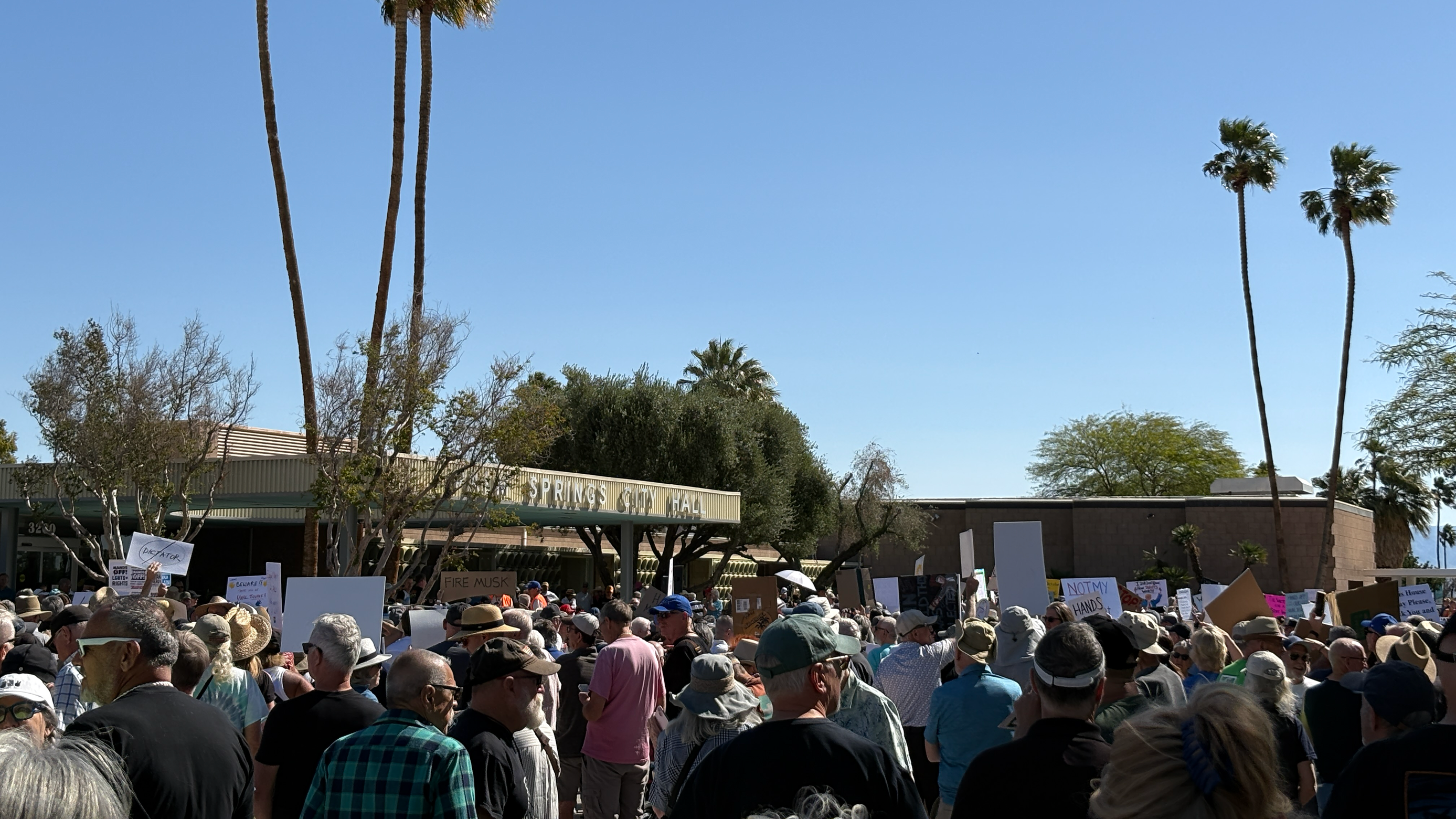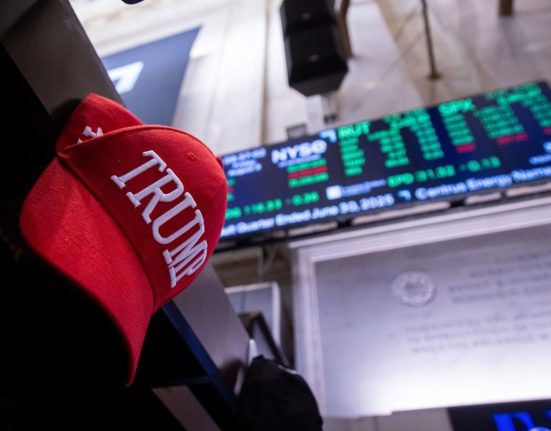
Hands Off protest against Trump, Musk in Palm Springs
People gather at Palm Springs City Hall on Saturday, April 5, 2025, to protest the actions of the Trump administration, including Elon Musk’s role.
This story was originally published by CalMatters. Sign up for their newsletters.
The investment chief who’s responsible for the retirement plans of 1 million California educators saw foreboding signs when he spoke to the state’s teachers’ pension board last month.
Scott Chan pointed to the torrent of executive orders and policy changes coming out of the new Trump administration and noted they “caused a tremendous amount of uncertainty in the marketplace” He warned of a recession, and a potential drop in stock markets of 20% or more.
“I would say that potential risks here are unprecedented. They are world changing,” said Chan, the chief investment officer at the California State Teachers’ Retirement System.
Two weeks later, President Donald Trump announced new tariffs against nearly every country, triggering a global financial shock that included the steepest stock market declines since the early days of the COVID-19 pandemic and wiped away trillions of dollars from investors’ portfolios.
The tariffs and the market plunge represent a new challenge for California’s underfunded pension plans, including Chan’s CalSTRS and the larger California Public Employees’ Retirement System. Combined, the two funds with headquarters on opposite banks of the Sacramento River hold more than $800 billion in assets and serve millions of beneficiaries.
CalPERS lost about $15 billion on Thursday and Friday, the first two days after Trump’s announcement. It held $516.5 billion on Monday morning. CalSTRS releases updates on its portfolio on a monthly basis. It likely recorded losses on a similar scale to CalPERS.
California’s retired teachers, cops, firefighters and other civil servants can count on their checks to keep coming. The threat of pension losses centers on government employers, such as cities and school districts, that would have to pay more money into the funds to make up for losses.
“It’s something we’re all bracing for and hoping there can be some course correction federally to allow us to steer the ship and recapture some of these losses,” said Dane Hutchings, whose firm, the California Public Policy Group, writes grants for and lobbies on behalf of California cities.
Terry Brennand, who watches CalPERS closely on behalf of the unions that represent public employees, likened the drop to the market crashes that followed the tech bubble of the 1990s and the housing downturn of the Great Recession.
“This one is not scam marketing or a bad market,” said Brennand of Service Employees International Union California, describing the economic conditions that preceded the downturns in 2000 and 2007. “We just turned the gun on ourselves and fired it.”
Trump has characterized the turmoil associated with the tariffs as a short-term pain that will ultimately make Americans wealthier by inducing companies to invest in domestic manufacturing. Members of his administration also have said the tariffs could prompt nations to seek new trading deals that would be more beneficial to the U.S.
“I don’t want anything to go down, but sometimes you have to take medicine to fix something,” Trump said to reporters on Sunday. “What’s going to happen to the markets, I can’t tell you. But our country is much stronger.”
What CalPERS and CalSTRS have to earn
But the tariffs carry the potential for a debilitating trade war, one of the risks that Chan highlighted to the CalSTRS board last month.
“It’s not so easy to say, ‘We’re going to assess tariffs on everybody else, but no one is going to assess tariffs on us,’” said California State Treasurer Fiona Ma, a Democrat. “We’re going to see a lot of anxiety and disruption, and we’re seeing that in the markets.”
Ma has a close look at the recent volatility from her seat on the boards overseeing CalPERS and CalSTRS. Her office also manages a mix of other public investments including bonds, college savings accounts and a kind of bank for local governments.
She said the stock market shock has not yet jeopardized other state and local finances. For instance, last week the state successfully sold creditors $2.6 billion in bonds — voter-approved loans that the state will pay down over time. And, local governments have not asked to pull money from their pooled investment fund.
Both big California public pension funds emphasize that they are long-term investors with diverse portfolios that do not rely solely on the stock market, but both are also under pressure to meet annual investment targets — 7% at CalSTRS and 6.8% at CalPERS. Their deadline to hit that sum comes every June 30.
Government agencies have to pay more to fund pensions when the funds miss those targets.
Looking for opportunities in market decline
Coming up short also can have long-term consequences. Both CalPERS and CalSTRS are considered underfunded because their portfolios are worth less than what they owe cumulatively to their beneficiaries. That’s partly because state lawmakers boosted retirement benefits for public employees during the dot-com bubble. Both funds have plans to become fully funded, and government workers hired after 2013 receive less generous benefits than the employees who preceded them.
So far, the market crash that followed the COVID-19 pandemic cost CalPERS and CalSTRS more money, at least at first, than the current downturn. Each fund recorded historically high returns the following year, softening the blow.
Stephen Gilmore, chief investment officer at CalPERS, in a written statement said the fund is “well-positioned to weather unsettled times.” He pointed to potential opportunities that could emerge in the shakeup:
“There’s still a lot to learn about the nature of the governmental actions that have taken place, especially when it comes to the imposition of new tariffs and their impact on GDP and inflation. On the upside, market volatility can present opportunities to buy assets that may be oversold relative to their real value. Those purchases can boost our portfolio in the years to come.”






